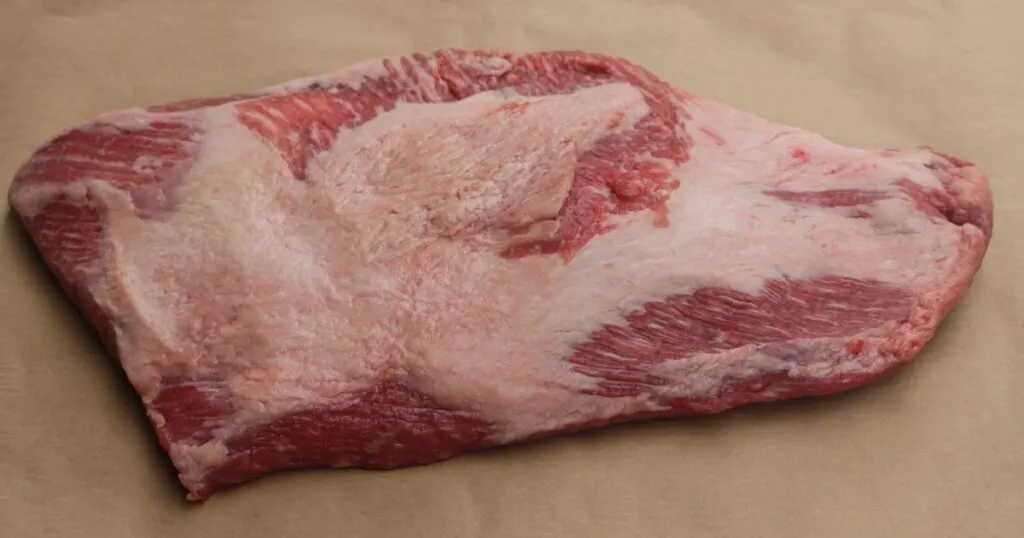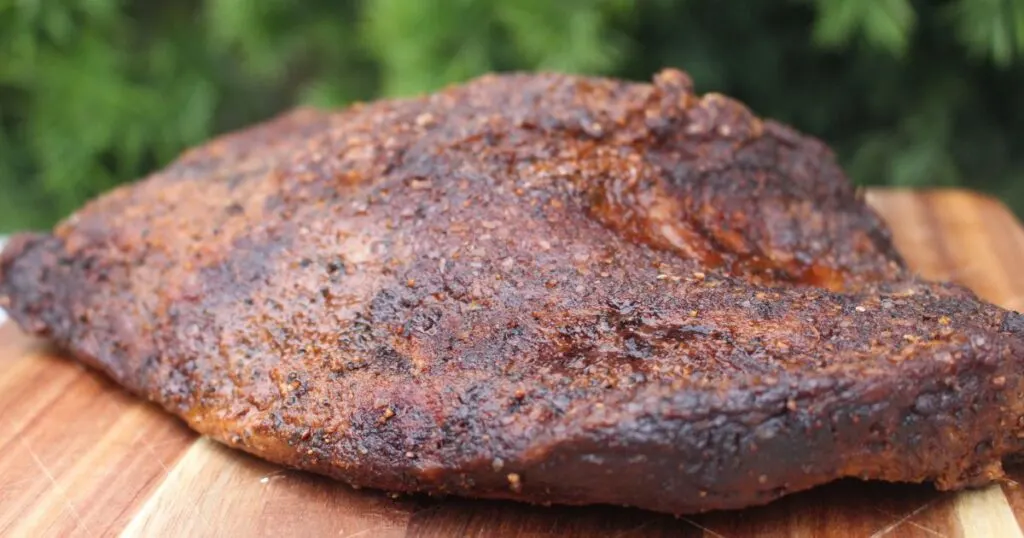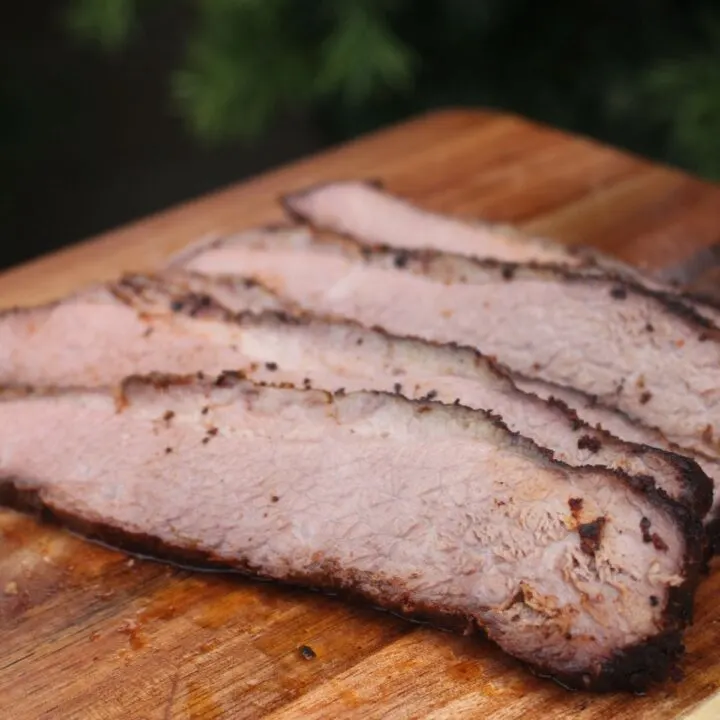Smoked Brisket is one of the easiest large cuts of meat to smoke. It takes time to achieve tender, juicy beef with bark and a smoke ring, but it is time well spent!
Smoked brisket is a staple of American barbecue for good reason. When done right, it’s tender, flavorful, juicy, and a crowd-pleaser at any gathering. However, smoking a brisket can be intimidating. Fortunately, with the right recipe and know-how, it is easy to achieve mouthwatering results. For this recipe, I chose a brisket flat since this part of the brisket is easier to smoke than a whole packer (and much less time-consuming).

Why You’ll Love Smoked Brisket
- Flavorful – You get tons of flavor from the dry rub, cut of beef, smoking wood, and cooking method. Basically, you have flavor coming at you in all directions, and wow, is it a treat!
- Perfect for gatherings – Smoked brisket is ideal for entertaining. Although leftovers are equally outstanding, it is made to feed a crowd.
- Simple ingredients – Chances are, you’ll only need to go out and purchase the brisket and smoking wood. The remaining ingredients are pantry staples waiting to be used to make something delicious.
- Bark – Smoked brisket is nothing without it! Bark is a combination of the spices from the dry rub and the proteins from the meat. During cooking, a chemical reaction occurs between the two resulting in a dark, intensely flavored crust forming over the beef.
- Versatile – With smoked brisket comes a world of possibilities. Serve slices with a side dish, make sandwiches, try brisket grilled cheese, brisket nachos, brisket tacos, pizza, you name it.
Smoked Brisket Ingredients Notes
To make smoked brisket, you’ll need the following:
- Brisket: Choose a well-marbled brisket flat with dark red meat. The fat cap should be clear white and free of any discoloration. Discoloration indicates that it’s been sitting on the shelf for a while. Lastly, brisket is labeled choice or prime at grocery stores and butcher shops. Go with prime when available. Choice ranges between 4-10% fat, while prime is 10-15% fat. When it comes to slow smokes, fat is vital, Franklin BBQ recommends about a 1/2 inch fat cap. It not only keeps the meat moist and tender, but the flavor it offers is phenomenal.
- Seasonings: Use your own seasoning, store-bought, or this easy dry mix. I kept it simple with a combination of salt, pepper, chili powder, onion powder, garlic powder, and oregano. The real stand-out ingredient of the rub is the type of chili powder used. Feel free to use any you have on hand, but New Mexico chile powder has an undertone of dried cherries that works well here.
- Smoking wood: Although not technically an ingredient, smoking wood is essential for smoked brisket. Hickory, oak, apple and cherry are great options. Hickory imparts an intense wood fire flavor with some sweetness and is reminiscent of bacon. On the other hand, oak brings an earthy smokiness that isn’t as intense as hickory but is more robust than fruit wood and burns longer. As for cherry, it’s an excellent choice if you like subtly smoked meat with fruity undertones.

Find the complete smoked beef brisket ingredients list with amounts in the recipe card below!
How to Make Smoked Brisket
- Prepare the brisket: Pat it dry to remove excess moisture, then trim any excess fat from the brisket, leaving a quarter-inch fat cap on top.
- Apply the rub: Combine the dry rub ingredients in a bowl and apply it all over the brisket.
- Leave it be: Transfer the seasoned brisket to a bowl or platter, cover, and leave it in the refrigerator for 8 hours. The rub not only adds flavor to the brisket but it promotes a better bark by drying out the surface of the beef.
- Prepare the smoker: Preheat the smoker to 250 degrees Fahrenheit and add the wood.
- Time to smoke: Transfer the brisket to the grates, close the lid and smoke for a few hours.
- Wrap it up: After some time, wrap the smoked brisket in butcher paper to speed up cook time and keep it moist as it cooks. The great thing about butcher paper is that although it covers the meat, the paper is breathable, thus allowing smoke through while not interfering with the formation of bark.
- Rest: Remove the smoked brisket from the grates and rest for 30 minutes. You never want to slice brisket immediately because all the juices will escape. Once rested, slice against the grain and serve.

Variations, Substitutions, and Cooking Tips
Use a meat thermometer – A meat thermometer is a must-have tool when smoking brisket. It ensures the meat is cooked to the proper temperature and helps avoid overcooking. Other methods to check doneness, like the poke test, aren’t very accurate.
Fat cap up – Place the brisket fat side up in the smoker to ensure the fat cap melts and bastes the meat as it cooks, resulting in a juicier brisket with more flavor. When it comes to the debate of fat-side up or fat-side down, there is no definitive right or wrong answer. Personally, I’ve experimented with both methods, and I find myself in the fat side up camp. If you’re still uncertain, do your own research and weigh the advantages of cooking the brisket with the fat side up or down.
Customize the rub – There are many ways to make the rub all your own. Add sugar, use different spices, change the herbs, or keep it simple with salt and black pepper. Your smoked brisket will be delicious no matter what.
Time to Smoke Brisket Per Pound – Plan to smoke a brisket about 1 hour and 30 minutes per pound (lb) while following the smoking directions to temperature.
The Brisket Stall – Expect the the temperature of the meat to stop rising after about two to three hours, when it hits 150°F to 170°F. This is normal with a large piece of meat and will eventually continue to rise.
Best Brisket Internal Temperature – The ideal temperature to pull brisket is at 195°F – 205°F. Keep in mind the brisket will continue to rise in temperature about 10°F while resting. Another good indicator that the brisket is done is if you can slide a thermometer in with similar resistance as warm butter.
Rest the meat – Resting smoked brisket after cooking allows the juices to redistribute, resulting in tender, juicy slices.

Smoked Brisket Recipe
Brisket is one of the easiest large cuts of meat to smoke. It takes time to achieve tender, juicy beef with bark and a smoke ring, but it is time well spent!
Ingredients
- 5-pound brisket flat
- 2 ½ tablespoons kosher salt
- 1 tablespoon black pepper
- 2 teaspoons garlic powder
- 2 teaspoons New Mexico chile powder
- 2 teaspoons onion powder
- 1 teaspoon dried oregano
- *You'll also need Butcher Paper
Instructions
- Pat the beef dry with paper towels, trim excess fat with a sharp knife, leaving a ¼-inch fat cap intact, and remove the silver skin.
- Combine the seasonings in a bowl to make the rub, then apply the rub all over the brisket. Gently massage it into the meat.
- Pop the brisket into a bowl, cover, and refrigerate overnight.
- Set the brisket out for an hour before smoking to bring it to room temperature.
- Preheat your smoker or wood pellet grill to 250 degrees Fahrenheit. I recommend hickory, oak, or cherry for this cook, but you can use any you like. If using chips, soak them in water for an hour.
- Transfer the brisket to the grill fat side up, close the lid, and smoke for 3 hours or until the internal temperature reaches 160-165 degrees Fahrenheit.
- Remove the brisket from the grill.
- Wrap the brisket in butcher paper (or foil in a pinch) while keeping it fat-side up, then return the wrapped brisket to the grates to smoke for 5-6 hours or until the internal temperature reaches 195 degrees Fahrenheit.
- Remove the brisket from the grill, rest for 30 minutes, then slice against the grain and serve as desired.
Notes
Use your own seasoning, store-bought, or the dry mix seasoning provided.
The ideal temperature to pull brisket is at 195°F - 205°F. Keep in mind the brisket will continue to rise in temperature about 10°F while resting. Another good indicator that the brisket is done is if you can slide a thermometer in with similar resistance as warm butter.
Nutrition Information:
Yield: 8 Serving Size: 8Amount Per Serving: Calories: 827Total Fat: 52gSaturated Fat: 21gTrans Fat: 0gUnsaturated Fat: 24gCholesterol: 301mgSodium: 1317mgCarbohydrates: 2gFiber: 0gSugar: 0gProtein: 82g
This data was provided and calculated by Nutritionix.
Troubleshooting Bark Not Forming
If there is no bark on your brisket it is often caused by one of 6 reasons.
- Rub: Not enough rub was applied which is crucial to forming the bark.
- Moisture: Too much moisture will cause the bark to not form and will also wash away rub. Refrain from spritzing too often or too much.
- Wrapping: Wrapping is called the Texas Crutch which speeds up the cooking process but also can trap moisture. As called for in this recipe, prior to wrapping, let the bark form by waiting for the brisket to achieve a minimum temperature of 160°F and a desired color and bark.
- Low Heat: Too low of a temperature can prevent the bark from forming so cook at a higher temp. This recipe calls for 250°F which is more than enough to ensure a bark forms.
- Smoke: The chemical reaction from the smoke aids in forming the bark. Not enough smoke or inconsistent smoke levels can result in the bark not forming.
- Fat Cap: Too much fat can prevent the bark from forming so trim more fat off until there is about half inch fat cap prior to smoking the meat.
Try These Recipes Next!
- Best Smoker Recipes
- Smoked Queso Dip
- Smoked Pork Chops
- Smoked Mac and Cheese
- Smoked Corn On The Cob
- Smoked Cabbage with Chili Lime Butter
- Amazing Grilled Cheese Burritos - April 11, 2024
- Stewed Turkey Necks - April 11, 2024
- Peanut Butter Biscoff Cottage Cheese Ice Cream - March 30, 2024